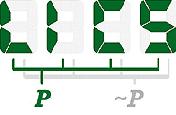Paper: Convergence Law for Random Graphs with Specified Degree Sequence (at LICS 2003)
Authors: James F. LynchAbstract
The degree sequence of an n-vertex graph is d, ..., d, where each d is the number of vertices of degree i in the graph. A random graph with degree sequence d, ..., d is a randomly selected member of the set of graphs on {0, ..., n-1} with that degree sequence, all choices being equally likely. Let \lambda, \lambda, ... be a sequence of nonnegative reals summing to 1. A class of finite graphs has degree sequences approximated by \lambda, \lambda, ... if, for every i and n, the members of the class of size n have lambdan + o(n) vertices of degree i. Our main result is a convergence law for random graphs with degree sequences approximated by some sequence \lambda, \lambda, .... With certain conditions on the sequence \lambda, \lambda, ..., the probability of any first-order sentence on random graphs of size n converges to a limit as n grows.
BibTeX
@InProceedings{Lynch-ConvergenceLawforRa,
author = {James F. Lynch},
title = {Convergence Law for Random Graphs with Specified Degree Sequence},
booktitle = {Proceedings of the Eighteenth Annual IEEE Symp. on Logic in Computer Science, {LICS} 2003},
year = 2003,
editor = {Phokion G. Kolaitis},
month = {June},
pages = {301--},
location = {Ottawa, Canada},
publisher = {IEEE Computer Society Press}
}
